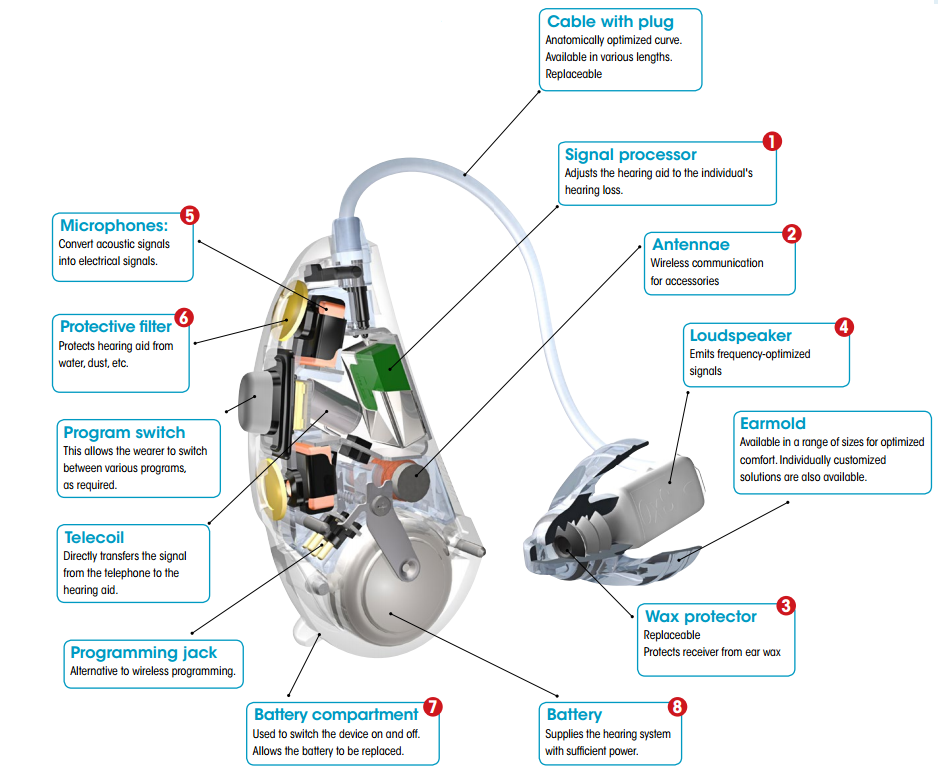How Do Hearing Aids Work? We Have A Look At Their Main Components
A hearing aid, in basic terms, is an amplification device to augment your hearing levels. The first hearing aids – ear trumpets – had no electronic parts and worked on the premise of increasing the area for collecting sounds to go into the ear. There was a small amount of amplification with these non-powered devices.
Today we have digital hearing aids that not only amplify sounds to the specifics of your hearing levels but modify and adjust the sound signal to a prescription designed to suit your hearing needs.

The main components of hearing aids
A hearing aid has four main components, and each has a specific role to play to make your hearing aid function effectively.
- Microphone
- Amplifier (processor)
- Receiver (speaker)
- Battery (power source)
1. Microphone
The microphone gathers the sound and directs it into the hearing aid. The role of the microphone is to collect the sound from the environment and change it into an electrical signal to be processed by the hearing aid. On each hearing aid there is a microphone port, behind this is a membrane and an electronic capacitor. The membrane and the capacitor work together to detect and measure sound and change the sound from an analogue to digital signal.
Most hearing aids have two microphones.
The two microphones together give the hearing aid directional capabilities. They can work together in difficult sound environments, cancelling out noise from a particular direction, so you only hear what’s in front of you. Make sure you ask your hearing healthcare professional how to keep your microphone clean so it can pick up sounds efficiently.
2. Amplifier
Since the introduction of digital technology in hearing aids, the amplifier has become a processor of the digitised information it receives from the microphone. It then amplifies this sound in accordance with the prescription for your individual hearing needs. Your audiologist or audiometrist can adjust certain characteristics of the signal before it is amplified. This includes modifying the speech signal, along with reducing wind noise, cancelling feedback, and altering the directional qualities of the sound.
There are many opportunities to adjust the signal via the processor before it is increased in volume. Enabling this to happen are powerful processing chips that allow the software packed into them to perform all these functions. Processing power is an important function of today’s hearing aids. Much engineering has gone into them to make them tiny but mighty to suit the needs of those who want to improve their communication abilities.
3. Receiver
The receiver’s role is not only to send information from the processor into the ear canal, but to determine the power and frequency range of the signal. If your hearing levels are severe, a more powerful receiver will be required. A receiver will take the processed signal and change it back into an audible sound signal to be sent to the ear drum, via what is known as acoustic coupling. This acoustic coupling will be the ear mould sitting in the ear canal.
So the receiver is there to send the amplified sound into the ear. For hearing aids that have the receiver sitting in the ear canal (receiver-in-canal and all in-canal hearing aids), keeping the receiver free of wax is imperative to ensure it is functioning effectively.
4. Battery
The battery is what powers the electronics of the hearing aid and enables it to function. Today’s hearing aids can be powered by disposable batteries or rechargeable ones. There are a number of parameters that determine how long your battery will last. Hearing aid disposable batteries are tiny, and the smaller your hearing aid is, the shorter the battery life (in general), as the battery will have to be smaller to fit into the device.
If you require more power to run your hearing aid, this can also drain the battery power source more rapidly. This again depends on the size of your hearing aid – bigger devices have bigger batteries that last longer. Rechargeable batteries will generally last a full day, to then be recharged overnight in their charging case. This too is dependent on how many features your hearing aid has, and if you use streaming for listening to music, phone calls and other audio signals.
Always talk to your hearing healthcare professional to see what power capabilities your batteries will provide.
Each brand of hearing aid will offer different microphone, processing/amplification, receiver, and battery options. Discuss what’s right for you and your hearing levels with your clinician to ensure you invest in the best device for your needs.
Need Help Finding Hearing Aids?


